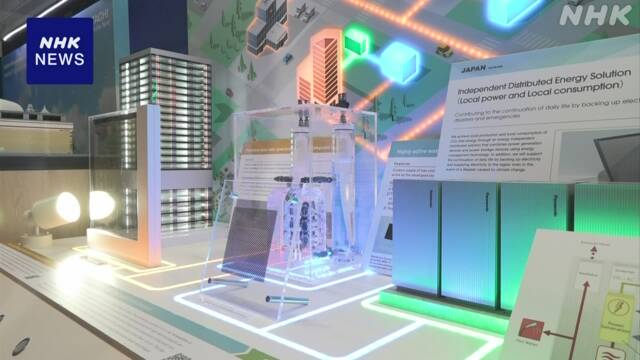COP28, the United Nations climate change conference held in Dubai, UAE = United Arab Emirates, is also a place for countries to disseminate technologies for decarbonization. Next-generation solar cells exhibited by Japan companies are also attracting attention.
At COP28 held in the UAE, an exhibition was set up to introduce Japan's efforts toward decarbonization, and 14 Japan companies are promoting the latest technologies.
Among them, Panasonic is exhibiting its next-generation solar cells.
It is a battery developed in Japan that uses a substance called "perovskite" that converts sunlight into electricity, and this company is promoting the technology that integrates with the battery by applying printing technology to glass and applying it.
It has the advantage of being able to generate power even in places where it was difficult to install batteries, such as on the walls of buildings, and this company hopes to increase the size of the battery in the future to further improve power generation efficiency.
In addition, Mitsubishi Heavy Industries (MHI) is exhibiting a technology to reduce carbon dioxide emissions by mixing hydrogen with high-efficiency gas-fired power generation, and aims to commercialize the technology to generate electricity using hydrogen alone around 2030.
As balancing the reduction of carbon dioxide emissions and sustainable growth has become an issue in Asian countries where economic growth continues, companies are aiming to expand overseas decarbonization technologies in which Japan has strengths.
Japan companies exhibit energy-saving technology appeal
In the pavilion where Japan companies exhibited in conjunction with COP28, there are also conspicuous exhibits that promote energy-saving technologies.
Among them, Daikin Industries, Ltd., a major air conditioning manufacturer headquartered in Osaka, exhibited for the first time at this year's exhibition and introduced its own air conditioner technology.
Air conditioning accounts for about 10% of the world's electricity demand, and its use is expected to increase with rising temperatures and economic growth in emerging countries, and how to reduce greenhouse gas emissions by saving energy is one of the discussions at this COP28.
For this reason, the manufacturer is now appealing to air conditioners equipped with inverters with high energy-saving performance.
The installed inverter is a device that can control the movement of the motor of the air conditioner, and since it can keep the temperature in the room constant with low power consumption, it is said that power consumption can be reduced by more than 1% compared to an air conditioner without an inverter.
However, according to the company, the penetration rate of air conditioners equipped with inverters is
▽ 100% in Japan and the EU = European Union ▽ 97% in China, while ▽ 70% in India ▽ 12%
in
Indonesia, etc.
Due to the high price and other bottlenecks, the penetration rate remains low.
In addition to strengthening sales to Southeast Asia and the Middle East, the company also wants to encourage these countries to introduce energy-saving regulations.
Mr. Shima Koyama, General Manager of the Department, said, "Air conditioners equipped with inverters are about 2% more expensive, but I think that the introduction cost can be recovered by reducing power consumption.
In addition, a start-up company in Osaka has developed a special sheet that has the effect of suppressing the rise in temperature in the room, and this was the first time that we exhibited it.
This sheet is processed in several thin layers of special resin that has the function of reflecting solar heat and "radiative cooling" to release heat, and when applied to the fabric of a tent or the roof of a building, it has the effect of lowering the temperature inside.
The company is aiming to expand its business as a technology that leads to energy conservation, and at a research institute in Osaka City, a sheet is actually attached to a tent or machine to demonstrate the difference in temperature compared to when not in use.
In the summer, the internal temperature can be lowered by more than 10 degrees, and the use of air conditioners can be suppressed, so power consumption can be expected to be reduced by about 40%.
Masahiro Suemitsu of SPACECOOL, the company that developed the seat, said, "This sheet can easily demonstrate the effect of the radiative cooling function just by attaching it, and through this conference, we would like to make people aware of the existence of this material and reduce the cost of air conditioning."

